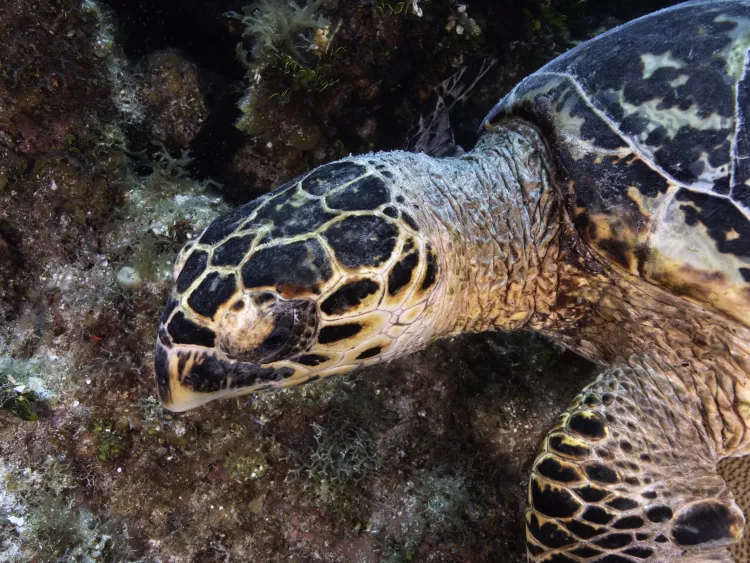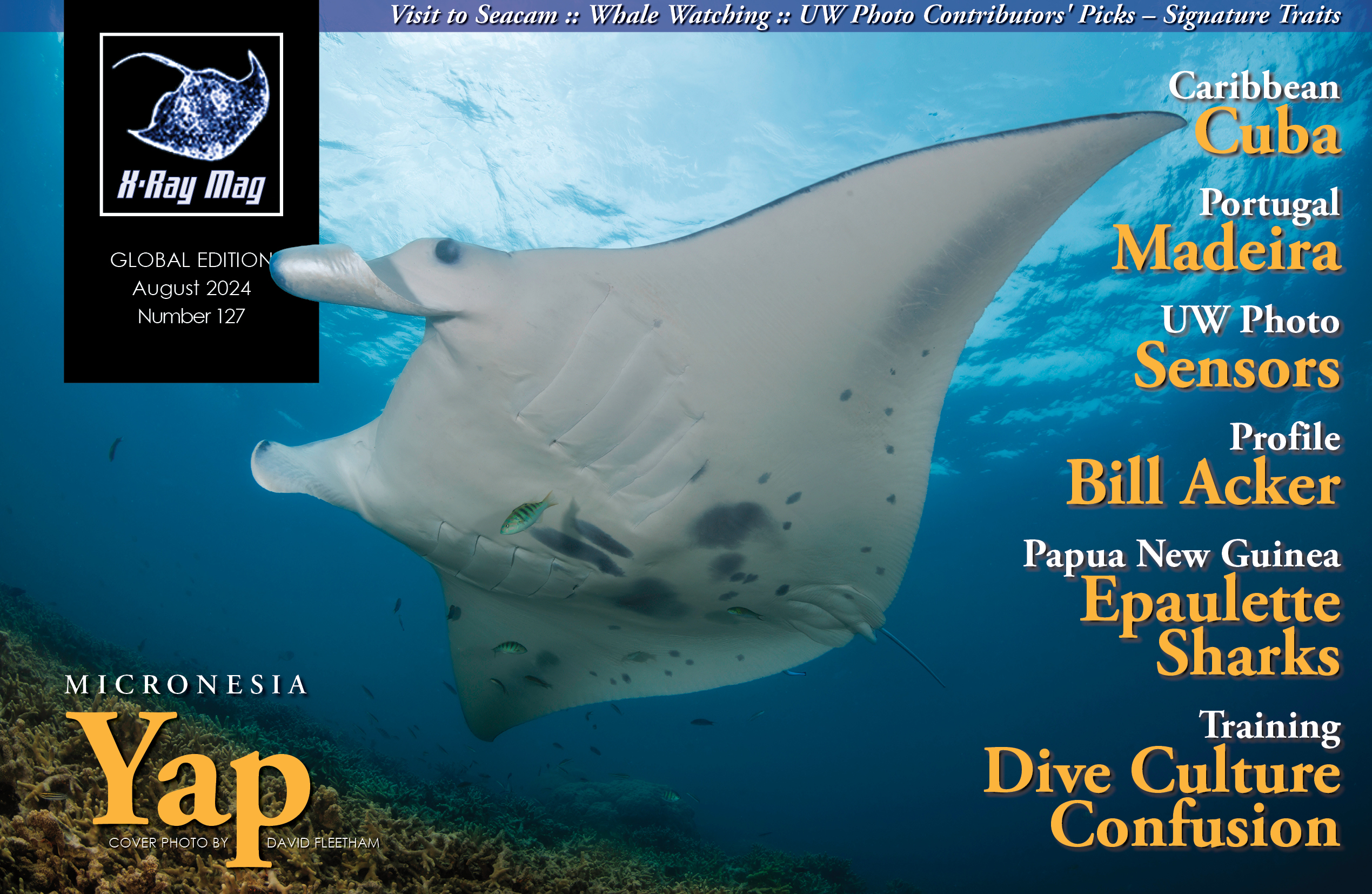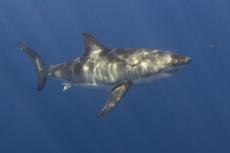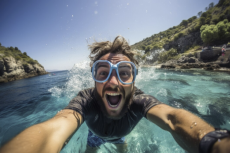We asked our contributors to share their favorite underwater images that showcase the distinctive features of various underwater creatures, and they returned with a broad selection of macro and wide-angle shots featuring a variety of marine life, from majestic sharks and sea turtles to tiny nudibranchs and crustaceans.
Contributed by
(To see all the images in the article, please scroll down to the end and download the PDF.)
Here, X-Ray Mag contributors share their selected images from the tropical waters of the Philippines, Indonesia, Malaysia, the Cayman Islands, Saba, the Bahamas, Isla Mujeres in Mexico, and Cocos Island in Costa Rica, to the subtropical and temperate waters of the US East Coast.
Instant Recognition
Text and photos by Gary Rose, MD
There are thousands of different species of fish that inhabit our oceans. Recognizing the different species and understanding the behavior of each is always a challenge. As divers navigate their way around shallow reefs in coastal waters or in the deeper blue water column, identification and understanding the behavior of different fish species will result in a safer and more rewarding experience. Conveniently, within the elasmobranchs (sharks), there are a few species that are instantly recognizable.
When I dive with new divers, I always enjoy the excitement they display when they instantly identify a nurse shark (Photo 1). The barbels (the two appendages that hang from the very front of the snout) are an instant giveaway. In addition, they have two equal-sized dorsal fins that are located far back on their bodies. Interestingly, over millions of years of evolution, the bottom portion of their tails has become absent as they spend most of their time lying on the sand and under coral outcrops.
I always love diving with tiger sharks. In the shallows of Tiger Beach, Grand Bahama Island, I have dived with 18 of them at one time. One only has to see a tiger shark to instantly identify it by its beautiful bars, bands and stripes. When they are young, the bars and bands are very dark and clearly delineated (Photo 2). With age, they fade but are still very visible. A word of caution: When diving with tiger sharks, you must always keep your head on a swivel and never, never lose eye contact.
Of all the sharks, my favorite is the great hammerhead. Fortunately, I get to see them from January to May on my weekly dives in Jupiter, Florida. I also love diving with them in the shallow, crystal-clear waters of Bimini, Bahamas. The huge dorsal fin, which is always taller than the thickness of their bodies, is a great identifier. But, the major instant identifier is their majestic cephalofoil, “the hammer”(Photo 3), which they gracefully swing from side to side to pick up minute electrical signals from their favorite food, the stingrays hiding buried in the sand.
Whale sharks are huge and can grow up to 33ft long (Photo 4). It is the unusual and beautiful surface markings of spots and bands that instantly identify these gorgeous sharks. Despite their enormity, they are filter feeders and eat only plankton, the smallest, almost microscopic creatures in our oceans. Isla Mujeres, Mexico, is a wonderful place to snorkel with whale sharks.
One of my favorite courses I teach is “Shark Behavior and Identification.” These four examples (Photos 1-4) are easily and instantly identifiable. There are many more species of sharks, and it can be very challenging to distinguish them from each other. As divers become more skilled with identification, they also gain knowledge of behavior, which results in greater enjoyment and safety. Visit: garyrosephotos.com

The Eyes of Cephalopods
Text and photos by John A. Ares
Cephalopods are some of the most fun creatures to dive with. Diving with squid, octopus and cuttlefish is always a treat. Since they are intelligent, they are naturally curious about us, and this frequently leads to some very interesting encounters instead of the usual flight reaction of most fish.
Their eyes are sophisticated and have a superficial resemblance to ours. However, their retinas do not have rods and cones. Instead, they have microvilli that are oriented in different positions, which enables polarized light sensitivity. (Hanlon & Messenger, 1996, p.17)
As shown here, their pupils have variable shapes. The octopus in Photo 1 was constantly observing our group of three divers near the wreck of the USS Liberty in Bali.
In Photo 2, the broadclub cuttlefish allowed a close approach to get a good close-up of its U-shaped pupil.
The flamboyant cuttlefish in Photo 3 is much smaller than the broadclub cuttlefish and is poisonous if eaten, hence the outrageous skin coloring. Unlike its cousin, the blue-ringed octopus, it does not inject venom. Visit: JohnAres.com
Source: Hanlon RT, Messenger JB. 1996. Cephalod Behaviour. Cambridge University Press. p.17.

Sea Turtles
Text and photos by Sheryl Checkman
There is something about sea turtles that makes me happy. When I see a turtle underwater, I know it is going to be a good dive. Today’s sea turtles are the living descendants of reptiles that have existed on Earth and in our oceans for 100 million years.
Sea turtles can be differentiated from tortoises, their land-based relatives, by their flippers. If a turtle has large flippers, it is a marine turtle. If it has claws rather than webbed toes or flippers, it is a tortoise. The patterns on the top (or carapace) of a turtle’s shell can be used to identify it. The number of lateral scutes (shell plates) and whether or not they overlap is one way to identify a sea turtle species. Another is the shape of its face.
Green and hawksbill turtles have four pairs of lateral scutes, while loggerheads have five pairs, and leatherbacks have none. The green turtle has a round face, while the hawksbill turtle has a pointed face with a distinct overbite. The hawksbill turtles in the first three photos were taken at Donna’s Delight in Little Cayman. You can see the pointed face and the overlapping scutes. The photo of the green turtle was taken at Man ‘O War in Saba. Notice its round face and how its scutes do not overlap. Both of these species of sea turtles have large geometrically-patterned flippers. Visit: Instagram.com/SherylCheckman

The Heroic Work of Cleaner Fish
Text and photos by Lureen Ferretti
The unsung heroes of the underwater world are the cleaner fish. Despite their tiny size, the ocean’s most ferocious predators and largest winged wonders, as well as marine life in general, line up for the cleaner fish’s invaluable “signature trait”—ridding their friends of pesky parasites, dead skin and infected tissue.
Cleaner fish position themselves in high-traffic areas of the reef to let passing marine life know they are open for business. These areas are referred to as cleaning stations. The community is diverse, with over 208 species of marine and freshwater cleaner fish.
Barberfish, Johnrandalia nigrirostris, are often seen gathered in small groups with lines of sharks waiting for a good cleaning. Especially after mating season, female sharks desperately need their wounds from mating bites attended to. They are graceful in their approach and nearly come to a complete stop as the barberfish work diligently as a team to remove dead and infected skin and parasites.
Reef manta rays, Mobula alfredi, are also known to frequent cleaning stations. Their approach is so slow that they seem to float motionless above the cleaning station while swarms of cleaner fish get to work. Not only do they clean the exterior of a fish, but they often enter the gills and mouths of their clients as well.
This is but a glimpse into the extraordinary lives and behaviors of cleaner fish. They may not be large or fierce, but they are definitely stars of the ocean floor. Visit: instagram.com/lureenferrettiphotography

Celebrating Crustaceans
Text and photos by Anita George-Ares, PhD
Crustaceans are noted for impressive diversity, including shrimps, crabs, lobsters and barnacles. Crustaceans share some similar traits, such as a hard exoskeleton, paired appendages and segmented body, but there are many exceptions. I enjoy photographing crustaceans because of their diverse forms and habitats.
Hingebeak shrimp (Photo 1) are found in groups near crevices or holes in a variety of habitats. I photographed two hingebeak shrimp that were in a vertical position. During post-processing, I cropped the image and rotated it 90 degrees to improve the composition.
Bubble corals have their own resident shrimp. In Photo 2, the bubble coral shrimp’s translucent body with distinctive purple lines makes a nice contrast against its bubble coral home.
Soft coral crabs are well camouflaged and not easy to find. The spines on the crab’s exoskeleton resemble the white spicules (support structures) of the soft coral (Photo 3). The crab attaches soft coral polyps to its body to mimic its host.
Hairy squat lobsters are a challenge to photograph. They are small, move continuously, and hide in the folds of giant barrel sponges. Our dive guide found the squat lobster in Photo 4. I cropped this image significantly to draw attention to the squat lobster’s unique form. Visit: facebook.com/profile.php?id=100016947967639

Animal Behaviors
Text and photos by Michael Rothschild, MD
To be a successful photographer of underwater sealife, you need some of the same talents as a hunter. You must understand animal behavior in order to capture the moment. A great photo can be the result of hours of patiently waiting for just the right composition. And if you do not know the animal’s traits, you will not get the shot, no matter how good your camera gear and image-making skills are. A circling shark, a ducking blenny, a territorial damselfish defending its rock… Anyone can press the shutter button, but knowing the animal allows you to make art.
All of these images were taken in the shallow waters near New York City. Photo 1 shows the sticky podia (tube feet) of a sea star navigating over a rocky bottom. Photo 2 shows a group of nudibranchs feasting on their favorite meal, the flower-like and sessile (but carnivorous) animals known as hydroids. Photo 3 shows a pair of cunners (also known as bergalls), which are fighting, mating, arguing, or maybe singing karaoke? And Photo 4 shows a very pretty bed of mussels of various sizes, with their inhalant and exhalant siphons on display as they filter the water for food and oxygen. Visit: dive.rothschilddesign.com

Green Sea Turtle
Text and photos by Larry Cohen
While diving in Sulawesi, Indonesia, I was fascinated by the pattern on the skin and shell of the green sea turtle. These turtles have existed for more than 110 million years. They allowed me to get extremely close and take photos that focused on the patterns, which are an example of nature’s exquisite graphic design.
The green turtle’s pattern is a signature trait. On its head, it has two prefrontal scales between its eyes, while most other turtles have four or five scales. The green turtle’s shell (carapace) is oval. The patterned sections of the carapace are called scutes. Green sea turtles have five central scutes and four lateral scutes.
The turtles have four flippers with an interesting pattern on the skin. In addition to swimming, they use their flippers to dig up food and to mate. Female turtles use their flippers to move up the beach for nesting. Visit: liquidimagesuw.com

Dark Eye Patch
Text and photos by Olga Torrey
The physical traits of fish show remarkable adaptability, with a limitless range of skin patterns and colors. These traits protect the fish, enabling them to blend in seamlessly with their surroundings. Many fish employ a vibrant array of colors for optical signaling, a complex and fascinating aspect of their biology. These colors can repel or attract other animals, mark territory, or even identify species or individuals. The ability of many fish to change their color through the movement of pigment within pigment cells adds another layer of intrigue. Black pigment cells, a common feature in fish, are often strategically placed alongside other pigment cells. Here are a few examples of fishes that share the dark eye patch as a physical trait. Visit: fitimage.nyc






























